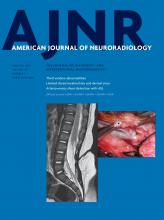Research ArticleNeurointervention
Treatment of Intra- and Extracranial Aneurysms Using the Flow-Redirection Endoluminal Device: Multicenter Experience and Follow-Up Results
F. Drescher, W. Weber, A. Berlis, S. Rohde, A. Carolus and S. Fischer
American Journal of Neuroradiology January 2017, 38 (1) 105-112; DOI: https://doi.org/10.3174/ajnr.A4964
F. Drescher
aFrom the Knappschaftskrankenhaus Bochum (F.D., W.W., S.F.), Universitätsklinik, Institut für Diagnostische und Interventionelle Radiologie, Neuroradiologie, Nuklearmedizin, Bochum, Germany
W. Weber
aFrom the Knappschaftskrankenhaus Bochum (F.D., W.W., S.F.), Universitätsklinik, Institut für Diagnostische und Interventionelle Radiologie, Neuroradiologie, Nuklearmedizin, Bochum, Germany
bKnappschaftskrankenhaus Recklinghausen Klinik für Radiologie Neuroradiologie und Nuklearmedizin (W.W.), Recklinghausen, Germany
A. Berlis
cKlinikum Augsburg (A.B.), Klinik für Diagnostiche Radiologie und Neuroradiologie, Augsburg, Germany
S. Rohde
dKlinikum Dortmund (S.R.), Klinik für Radiologie und Neuroradiologie, Dortmund, Germany
A. Carolus
eKnappschaftskrankenhaus Bochum (A.C.), Universitätsklinik, Klinik für Neurochirurgie, Bochum, Germany.
S. Fischer
aFrom the Knappschaftskrankenhaus Bochum (F.D., W.W., S.F.), Universitätsklinik, Institut für Diagnostische und Interventionelle Radiologie, Neuroradiologie, Nuklearmedizin, Bochum, Germany

References
- 1.↵
- Fischer S,
- Vajda Z,
- Aguilar Perez M, et al
- 2.↵
- Brinjikji W,
- Murad MH,
- Lanzino G, et al
- 3.↵
- D'Urso PI,
- Lanzino G,
- Cloft HJ, et al
- 4.↵
- Briganti F,
- Napoli M,
- Tortora F, et al
- 5.↵
- Rankin J
- 6.↵
- Joshi MD,
- O'Kelly CJ,
- Krings T, et al
- 7.↵
- Colby GP,
- Lin LM,
- Caplan JM, et al
- 8.↵
- Möhlenbruch M,
- Herweh C,
- Jestaedt L, et al
- 9.↵
- Sadasivan C,
- Cesar L,
- Seong J, et al
- 10.↵
- Tan LA,
- Keigher KM,
- Munich SA, et al
- 11.
- 12.
- 13.
- Lubicz B,
- Van der Elst O,
- Collignon L, et al
- 14.
- De Vries J,
- Boogarts J,
- Van Norden A, et al
- 15.
- Fischer S,
- Aguilar-Pérez M,
- Henkes E, et al
- 16.↵
- Buyukkaya R,
- Kocaeli H,
- Yildirim N, et al
- 17.↵
- Faragò G,
- Caldiera V,
- Tempra G, et al
- 18.↵
- Gurbel PA,
- Bliden KP,
- Hiatt BL, et al
- 19.↵
- Petricevic M,
- Milicic D,
- White A, et al
- 20.↵
- Fifi JT,
- Brockington C,
- Narang J, et al
- 21.↵
- Nakagawa I,
- Park HS,
- Yokoyama S, et al
- 22.↵
- Oran I,
- Cinar C,
- Bozkaya H, et al
- 23.↵
- Kocer N,
- Islak C,
- Kizilkilic O, et al
- 24.↵
- 25.↵
- Kulcsár Z,
- Houdart E,
- Bonafé A, et al
- 26.↵
- Kallmes DF,
- Hanel R,
- Lopes D, et al
- 27.↵
- Turowski B,
- Macht S,
- Kulcsar Z, et al
- 28.↵
- Thielen E,
- McClure M,
- Rauchaud A, et al
In this issue
American Journal of Neuroradiology
Vol. 38, Issue 1
1 Jan 2017
Advertisement
F. Drescher, W. Weber, A. Berlis, S. Rohde, A. Carolus, S. Fischer
Treatment of Intra- and Extracranial Aneurysms Using the Flow-Redirection Endoluminal Device: Multicenter Experience and Follow-Up Results
American Journal of Neuroradiology Jan 2017, 38 (1) 105-112; DOI: 10.3174/ajnr.A4964
0 Responses
Jump to section
Related Articles
- No related articles found.
Cited By...
- Efficacy and safety of the dual-layer flow-diverting stent (FRED) for the treatment of intracranial aneurysms
- On Flow Diversion: The Changing Landscape of Intracerebral Aneurysm Management
- SAFE study (Safety and efficacy Analysis of FRED Embolic device in aneurysm treatment): 1-year clinical and anatomical results
- Transient in-stent stenosis at mid-term angiographic follow-up in patients treated with SILK flow diverter stents: incidence, clinical significance and long-term follow-up
- Feasibility, complications, morbidity, and mortality results at 6 months for aneurysm treatment with the Flow Re-Direction Endoluminal Device: report of SAFE study
- European Multicenter Study for the Evaluation of a Dual-Layer Flow-Diverting Stent for Treatment of Wide-Neck Intracranial Aneurysms: The European Flow-Redirection Intraluminal Device Study
- Multicenter Experience with FRED Jr Flow Re-Direction Endoluminal Device for Intracranial Aneurysms in Small Arteries
This article has not yet been cited by articles in journals that are participating in Crossref Cited-by Linking.
More in this TOC Section
Neurointervention
Similar Articles
Advertisement











